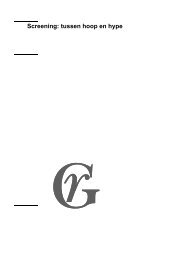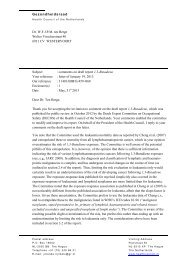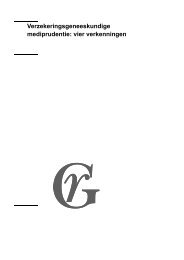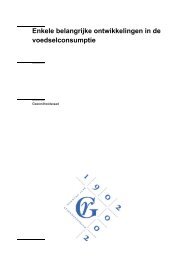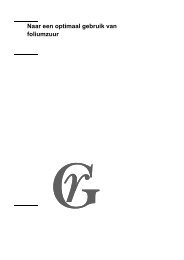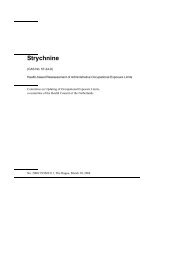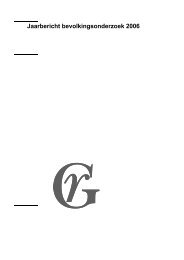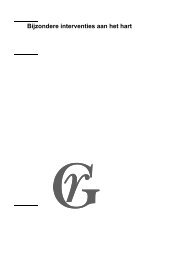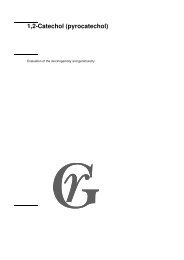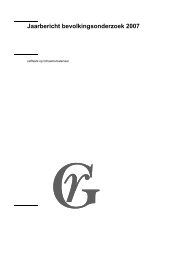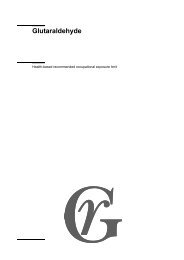Liquefied petroleum gas (LPG) - Gezondheidsraad
Liquefied petroleum gas (LPG) - Gezondheidsraad
Liquefied petroleum gas (LPG) - Gezondheidsraad
Create successful ePaper yourself
Turn your PDF publications into a flip-book with our unique Google optimized e-Paper software.
increases (not statistically significant: p>0.05) in bronchoconstriction and<br />
respiratory depression at the high level, but no arrhythmia or myocardial<br />
depression (Bel74, Avi75). In anaesthetised mice and unanaesthetised dogs,<br />
propane did not induce arrhythmias either but (weakly) sensitised the heart to<br />
epinephrine-induced cardiac arrhythmias at concentrations of ca. 180,000 and<br />
360,000 mg/m 3 (100,000 and 200,000 ppm), but in dogs not at ca. 90,000 mg/m 3<br />
or 50,000 ppm (exposure time: mice: 6 minutes; dogs: 10 minutes) (Avi74,<br />
Rei71). Similar effects were observed in dogs exposed to concentrations of ca.<br />
280,000 to 1,656,000 mg/m 3 (150,000-900,000 ppm) for 10 minutes (Low87a).<br />
In another study, propane was a weak cardiac sensitiser in dogs: the EC 50<br />
was ca.<br />
33,000 mg/m 3 (18,000 ppm) (exposure time: 5 minutes) (Cla82).<br />
The committee did not find data from repeated-dose toxicity studies<br />
(including carcinogenicity and reproduction toxicity) on propane alone.<br />
Propane (purity: >99.9%) did not induce mutations when tested with and without<br />
an induced rat liver metabolic activation system in S. typhimurium strains<br />
TA1535, TA1537, TA1538, TA98, and TA100 at concentrations of 5-50% (v/v)<br />
in a desiccator (exposure time: 6 hours) (Kir80).<br />
Butane<br />
Injection of liquid butane into the anterior eye chamber of rabbits did not cause<br />
disturbance, and all effects disappeared in 2-4 days (Gra74).<br />
Kane and Alarie exposed groups of male Swiss-Webster mice to<br />
photochemical oxidant mixtures generated by a reaction between various<br />
hydrocarbons, among which butane, and nitrogen dioxide in the presence of<br />
ultraviolet light. Meanwhile, the respiratory rates of the mice were monitored.<br />
The initial hydrocarbon concentrations ranged from 0.4 to 18 ppm (0.9-42.7<br />
mg/m 3 ) with the initial nitrogen dioxide concentration being one-third of the<br />
initial hydrocarbon concentration. Concomitant exposure to butane and nitrogen<br />
dioxide did not significantly affect respiratory rate, indicating no irritation of the<br />
upper respiratory tract. The authors also reported that butane did not cause<br />
irritation to the eyes of the mice (Kan78). In guinea pigs, exposure to<br />
concentrations of butane of 21,000-56,000 ppm (ca. 50,800-135,000 mg/m 3 )<br />
caused increased respiratory rate, sniffing, and chewing movements, animals<br />
recovering quickly after cessation of exposure (Low87b).<br />
Acute LC 50<br />
values were 658,000 and 680,000 mg/m 3 (ca. 270,000 and<br />
279,000 ppm) in rats (exposure duration: 4 hours) and mice (2 hours),<br />
respectively (Shu69). In mice, 40 and 60% of the animals died at 2-hour<br />
exposures to ca. 653,000 and 750,000 mg/m 3 (270,000 and 310,000 ppm),<br />
134-11 <strong>Liquefied</strong> <strong>petroleum</strong> <strong>gas</strong> (<strong>LPG</strong>), Propane, Butane



